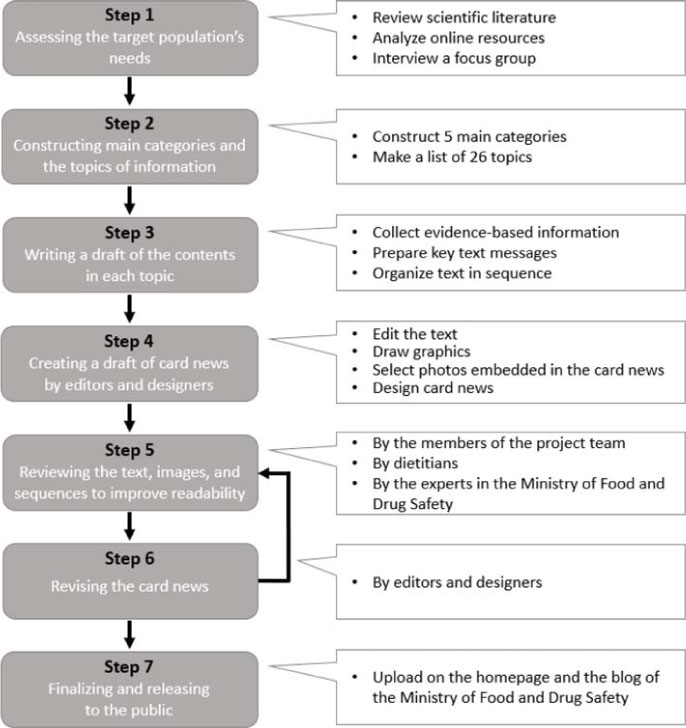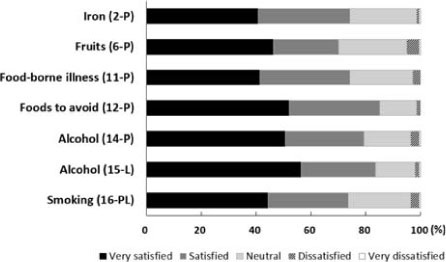References
1. Brown JE. Nutrition through the life cycle 4th edth ed. Belmont, CA, USA: Wadsworth Publishing; 2011. p. 87–221.
2. Han YS, Lee SS. Association of nutrient intake and pregnancy outcome with gestational weight gain. J Nutr Health 2010;43(2):141–151.
4. Kim J, Park MS, Lee JW. Nutritional status and eating behavior of lactating women in Daejeon. Korean J Community Nutr 2011;16(1):37–50.
5. Kim SB, Kim JW, Kim MH, Cho YS, Kim SN, Lim HS. A study on consumer's needs for development of diet guide application for pregnant women. Korean J Community Nutr 2013;18(6):588–598.
6. Kim MJ. Nutritional status, eating habit, knowledge level and obstetric outcome in pregnant women with old age [master's thesis] Hanyang University; 2014.
7. Bensley RJ, Hovis A, Horton KD, Loyo JJ, Bensley KM, Phillips D. Accessibility and preferred use of online web applications among WIC participants with internet access. J Nutr Educ Behav 2014;463 Suppl. :S87–S92.
8. Sayakhot P, Carolan-Olah M. Internet use by pregnant women seeking pregnancy-related information: a systematic review. BMC Pregnancy Childbirth 2016;16(1):65.
9. Lupton D, Pedersen S. An Australian survey of women's use of pregnancy and parenting apps. Women Birth 2016;29(4):368–375.
11. Kim JW, Lee EJ. Current status of dietary education applications (App) as a smart education material. J Korean Pract Arts Educ 2013;26(4):81–110.
12. Hearn L, Miller M, Lester L. Reaching perinatal women online: the Healthy You, Healthy Baby website and app. J Obes 2014;2014:573928.
13. Tobey LN, Manore MM. Social media and nutrition education: the food hero experience. J Nutr Educ Behav 2014;46(2):128–133.
14. Lee EJ, Hwang GW. Cardnews marketing Seoul: Sanggakbihaeng; 2016. p. 13–35.
15. Jung SY. Analysis of the current utilization situation and type of the card news of the big data era. J Korean Soc Des Cult 2015;21(4):609–620.
16. Linden K, Berg M, Sparud-Lundin C. Web-based information for pregnant women and new mothers with type 1 diabetes- a description of the development process. BMC Med Inform Decis Mak 2012;12(1):134.
17. Joo HS, Kim CB, Nam EW, Lee MY, Park MB. Comparison of health-related behaviors in pregnant women and breast-feeding mothers vs non-pregnant women. Korean J Women Health Nurs 2014;20(3):185–194.
19. Koo YJ, Lee DH. Hypertension in pregnancy. J Korean Med Assoc 2016;59(1):24–30.
20. Statistics Korea. 2015 Annual report of live births and deaths statistics (based on vital registration) [internet] Statistics Korea; 2016. cited 2017 May 3. Available from:
http://kosis.kr/ups/ups_01List.jsp.
21. Yoo T, Han YH, Kim JH, Lee MJ, Hyun T. Development of nutrition education contents for pregnant women based on effective communication strategies. Korean J Community Nutr 2017;22(2):115–126.
26. Ahn HS, Lee Y, Oh YJ. Perception and service needs about nutrition education of pregnant and lactating: to compare with pregnant and lactating women, health specialist and college women. Korean J Community Nutr 2006;11(3):327–337.
27. Kim JE, Park DY. A study on the actual conditions and needs for nutrition education for pregnant women in health centers. Korean J Community Living Sci 2007;18(4):687–698.
28. Ministry of Health and Welfare. The Korean Nutrition Society. Dietary reference intakes for Koreans 2015 Sejong: Ministry of Health and Welfare; 2015.
30. Ministry of Food and Drug Safety. Food safety information [internet] Ministry of Food and Drug Safety; 2014. cited 2017 May 22. Available from:
http://www.foodsafetykorea.go.kr/.
31. National Institute of Agricultural Sciences. Food composition table 8th revisionth ed. Suwon: National Institute of Agricultural Sciences; 2011.
32. The Korean Nutrition Society. Food values Seoul: The Korean Nutrition Society; 2009.
33. Kim JH, Lee EJ, Hyun T. Dietary folate intake and food sources of children and adolescents in Chungcheong area: using nutrient database revised by measured folate in selected foods. J Nutr Health 2015;48(1):94–104.
36. Han JY. Maternal-fetal toxicology 2nd edth ed. Paju: Koonja; 2016.
37. Ministry of Health and Welfare. Korea Centers for Disease Control and Prevention. Korea Health Statistics 2014: Korea National Health and Nutrition Examination Survey (KNHANES VI-2) Sejong: Ministry of Health and Welfare; 2015.
38. Chien YC, Liu JF, Huang YJ, Hsu CS, Chao JC. Alcohol levels in Chinese lactating mothers after consumption of alcoholic diet during postpartum “doing-the-month” ritual. Alcohol 2005;37(3):143–150.
41. Kim SK. Diagnosis and management of thyroid disease in obstetrics and gynecology In : Proceedings of 2016 Training lecture of the Korean Association of Obstetricians and Gynecologists; 2016 May 20; Busan:. p. 107–109.
42. Kim JE, Park DY. A study on pregnant women's experience about nutrition education. Korean J Community Living Sci 2012;23(3):347–356.
43. Kim BK, Park HR, Kim JW. Development of comic books and an animation as dietary education materials for children. Korean J Community Nutr 2008;13(5):630–639.
44. Yon M, Park C, Yoo KH, Hyun T. Development and evaluation of a nutrition education website for the prevention and management of childhood obesity. Korean J Community Nutr 2012;17(4):390–406.
45. Cho JH, Kim SB, Kim SK, Kim MH, Kim GS, Kim SN. Development of ‘children's food avatar’ application for dietary education. Korean J Community Nutr 2013;18(4):299–311.
46. Maher CA, Lewis LK, Ferrar K, Marshall S, De Bourdeaudhuij I, Vandelanotte C. Are health behavior change interventions that use online social networks effective? A systematic review. J Med Internet Res 2014;16(2):e40.
47. Mita G, Ni Mhurchu C, Jull A. Effectiveness of social media in reducing risk factors for noncommunicable diseases: a systematic review and meta-analysis of randomized controlled trials. Nutr Rev 2016;74(4):237–247.
48. Ministry of Food and Drug Safety. Food and nutrition guide for pregnant and lactating women [internet] Ministry of Food and Drug Safety; 2017. updated 2017 Feb 16. cited 2017 Jun 8. Available from:
http://www.mfds.go.kr/index.do?mid=675&seq=35746.





